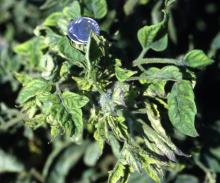Cause The beet curly top virus, which also infects a wide range of crops such as bean, beet, cucurbits, spinach, squash, and pepper. The virus is disseminated by the beet leafhopper, Circulifer tenellus. There are no reports of seed transmission. The disease may be severe in central and eastern Oregon and Washington. It occurs in the Willamette Valley, especially the northern end when winds blowing through the Columbia Gorge transport the beet leafhopper from eastern Oregon.
The leafhopper takes up the virus when feeding and keeps it in its body the rest of its life. Normally, the virus must incubate 21 to 24 hours or longer in the insect's body before it can be transmitted to another plant, but if the temperature is very high incubation may be reduced to 4 to 6 hours. Leafhopper eggs never carry the virus.
Temperature affects the interval between the insect's feeding and the appearance of curly top symptoms. If it is very hot, symptoms may show in 24 hours; with normal temperatures, in 7 to 14 days; in cool weather, up to 30 days. The disease is in areas where light is intense, summer heat is prolonged, relative humidity is low, and evaporation is rapid. In years when average relative humidity is 35%, the disease is very severe; when it is over 50%, there is almost no curly top. Shading, which lowers light intensity and retards evaporation, probably delays leafhopper visits, decreases the infection rate, and reduces symptom expression.
Symptoms Leaflets roll up and twist sharply, exposing their undersurfaces. Foliage is stiff and leathery, and the entire plant is a peculiar dull yellow. Leaflet veins purple, and the plant often is stunted. Many roots and rootlets die, as do severely affected plants. Can be confused with aster yellows.
Cultural control Many controls, including trying to control the leafhopper vector, have not produced satisfactory results.
- These varieties are resistant to curly top (those marked VF also are resistant to Verticillium and Fusarium wilt): Payette, Owyhee, Super Star VF, Red Lode VF, Ida-Red VF, Parma VF, Bicentennial VF, Rowpac VF, Columbia VF, Roza VF, and Salad Master VF.
- Shading plants helps avoid leafhopper attack in home gardens.
References Bennett, C.W. 1971. The Curly Top Disease of Sugarbeet and Other Plants. Monograph 7. St. Paul. MN: American Phytpathological Society.
Jones, J.B., Jones, J.P., Stall, R.E., and Zitter, T.A. 1991. Compendium of Tomato Diseases. St. Paul, MN: APS Press.


